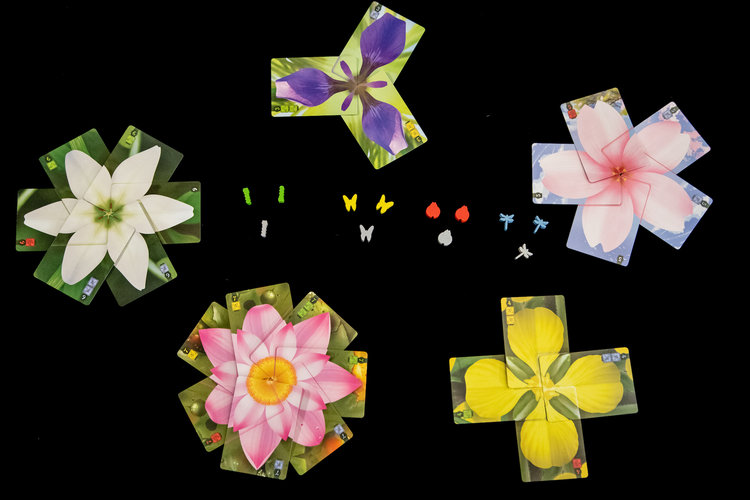Plant a Garden One Flower at a Time in Lotus

Five different types of flowers abound in the garden. Send your insect guardians to claim them and earn points for each petal you collect.
Control the ladybugs, the butterflies, the caterpillar, and the dragonfly, as you create each flower one petal at a time in a game as lovely to look at as it is to play.
Gameplay
In Lotus, each player chooses one of the four types of insects in the game to be their guardians. You then take the deck that belongs to that guardian and two matching meeples. A communal deck is set to one side and four cards are drawn from it. Every card shows one petal of a flower. There are five different types of flower, and a number on each card tells you how many petals are needed to complete that flower type. Cards in your personal deck also show one or two copies of your personal insect guardians.
On your turn you must perform two actions. You have three possible actions to choose from, and may perform the same action twice. 1) You may play one or two petal cards from your hand onto the table, either starting a new flower if that flower type is not currently being built, or adding them onto a flower that is still incomplete. 2) You may place one or two cards from your hand to the bottom of your player deck and draw the same number into your hand. 3) You may move one of your meeples onto any incomplete flower. Finally, after taking your actions, you draw back up to your hand total of four cards; you may draw from your deck and/or from the four cards from the communal deck that are face up on the table (these are refilled if needed at the end of your turn).
When the last petal of a flower is added, the flower is complete and two things happen. The player with the most guardians on the flower (including both meeples and those that appear on cards from their player deck) is considered to be in control of the flower and can choose either five points or to take one of three power ups (these include a five card hand limit, allowing you to add more cards to a flower on your turn, and an extra guardian meeple that counts for two when determining control of flowers). Finally, the player who actually completed the flower takes all the petals in the flower and puts it in their score pile. Each petal card in your score pile is worth one point at the end of the game.
Once a player runs out of cards in their draw deck, the game ends. The player with the most points wins.

Review
Lotus is a charming game with a pleasant, cozy atmosphere. Building the flowers is visually appealing and the game has lovely artwork that matches the low-key nature of the game nicely.
Each flower card shows exactly where you should overlay the next card. This is a great feature, as it both helps to ensure that the completed flower looks attractive but also makes it easier to keep track of how many petals each bud still needs.
There are some interesting choices to make in the game, particularly juggling the advantages of having control over a flower with those of completing it, and the order you select the power ups (or if you choose them at all) have a solid impact on the game.
With two players there is a lot of back and forth, and which flowers you have to worry about is slightly more predictable, but the game is still enjoyable. With three to four players this isn't an issue.
Lotus has high quality components, pretty artwork, and engaging gameplay, with some intriguing choices and a pleasant air. Well worth the play for those days you just need something that is placid and laid back.
Pros: Pleasant atmosphere and theme, nice artwork, some fun strategic choices
Cons: Better with three or four players
Disclosure: we received a complimentary review copy of this game.







